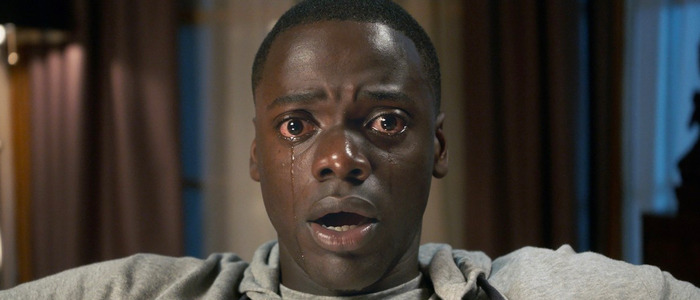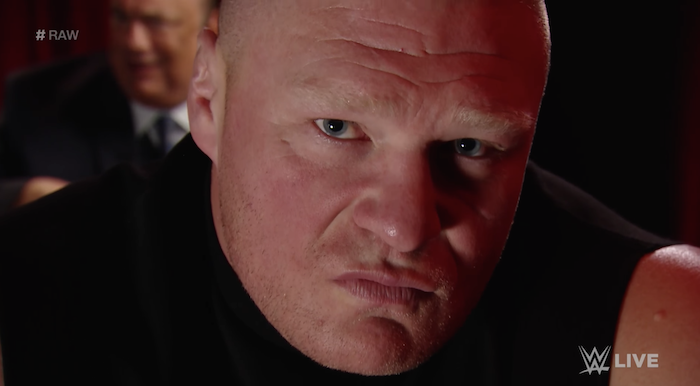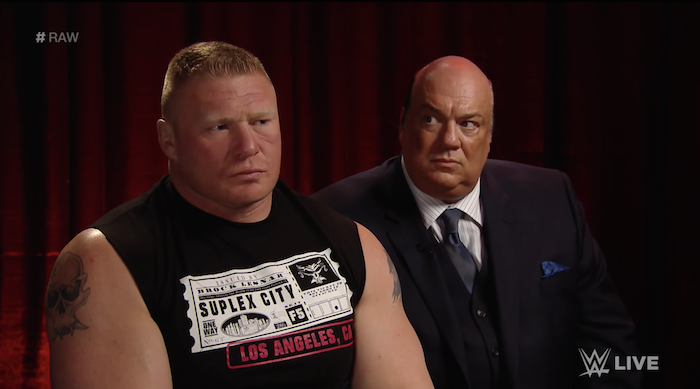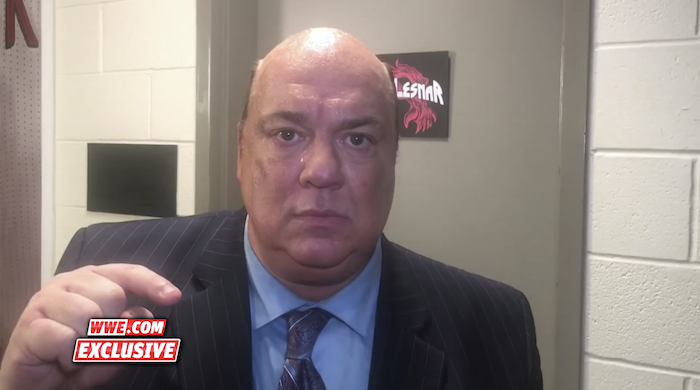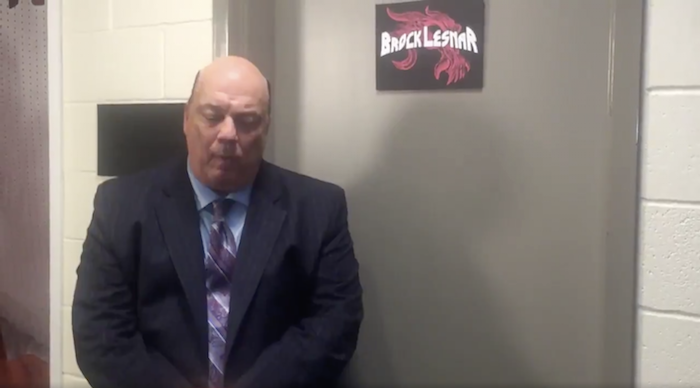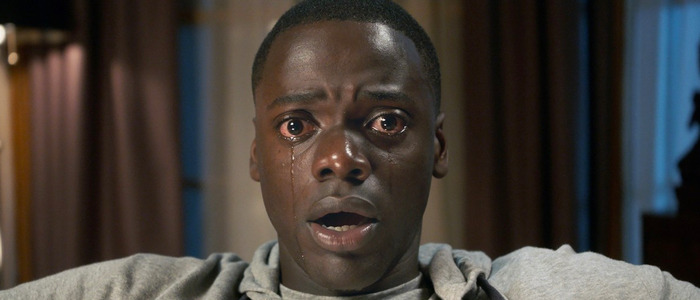One Of 2018's Best And Most Nuanced Performances Has Been Happening On WWE (And No, This Is Not A Joke)
Picture, if you will, a middle-aged white man; broken, disheveled, perhaps even remorseful. A character who's spent years pursuing a twisted ideal that now pushes back, struggling to accept this reality as he re-calibrates his place in the world.
It sounds like a "prestige" American cable drama, doesn't it? In the case of character Paul Heyman however, a slimy lawyer played by producer and inadvertent actor Paul Heyman, it happens to be a fixture of American wrestling. No, not the Olympic sport. The trashy, "lowbrow" one. The one broadcast on Monday nights, where women in skimpy outfits would mud-fight for rowdy crowds while men bashed each other's skulls in with folding chairs for our entertainment. At least, that's how things used to be.
Watch a clip from this week's episode of WWE Monday Night Raw. No context required, other than the fact that last week, Paul Heyman's friend and long-time client, former UFC fighter Brock Lesnar, put their relationship into words while grabbing Heyman by the throat: "Let's get something straight. We're not friends, Paul. You work for me. I don't work for you."
This follow-up scene, shot in the form of a tell-all interview, features one of the best performances currently on television. Not only as a self-contained moment of character, but part of a larger story that's been going on for 16 years:
Would it surprise you if I said there had been Emmy talk about this performance all week long? I'm not in the habit of award prognostication, but until a few months ago, it would've surprised me too. And yet, WWE's creative direction in recent years — often called the "PG era," where the aim has been mainstream acceptance — and their recent billion-dollar deal with Fox seem to indicate a bid to be taken more seriously. The company even had its first ever Emmy submission and campaign earlier this year. Stranger things have happened, but regardless of gold statues or lack thereof, Heyman's long-running performance, which rides the line between melodrama and subtlety, is a great opportunity to talk about acting itself.
A Brief History
The modern age of "Sports Entertainment" brought with it both a scaling back on the carnage and a renewed focus on women as competitors rather than sex objects, but an effect of this shift in the streaming age that tends to be glossed over is the evolution of its storytelling. Not just what stories are told, but rather, how. For the last seven years, WWE and the wrestling industry at large have leaned in to the artifice, smashing the fourth wall by bringing audiences into wrestlers' personal lives. Publicly breaking character or "kayfabe," once a cardinal sin, is the new norm (zombie-mortician-Hell-wizard The Undertaker now has an Instagram) and stories frequently veer into metatext based on what fans have heard has been going on behind-the-scenes, building on expectations. In 2014, fans began to disrupt shows by chanting the name of a beloved wrestler, Daniel Bryan, who wasn't getting enough opportunities, so WWE dramatized this by having fans occupy the ring.
Most recently, WWE Universal Champion Brock Lesnar showed up at the UFC — wrestling's violent, unscripted, combat-sport cousin — further fueling rumours of his return to Mixed Martial Arts. Wrestling fans don't normally like when their champ turns their backs on them; Dwayne "The Rock" Johnson was a villain shortly before his departure for Hollywood in 2004, and a similar phenomenon has been taking place with Lesnar these past few months. As a big box-office draw, Lesnar doesn't need to adhere to WWE's rigorous schedule (his expensive part-time contract allows for a small handful of appearances) and his absence doesn't sit well with fans. It wouldn't with fans of any other show; people like to see their favourite characters actively involved in the narrative.
Where does Paul Heyman fit in to all this? He considers himself Lesnar's friend, though he fills the on-screen role of the ringside manager, referring to himself as Lesnar's "advocate," as he cheers him on from the sidelines. Usually, his function would end there, but Lesnar's the strong, silent type, while Heyman cracks wise and puts the verbal beat down on anyone who tries to step to the champ. Their dynamic is simply made for television.
Generally, making it in wrestling requires the ability to perform both in-ring and on the microphone. You have to be a stellar physical storyteller and stunt performer, but you also have to be able to cut "promos" that advance the narrative by speaking to both other wrestlers and to the audience at large. The Rock had these abilities in droves, as does WWE's current flagship performer John Cena, though both men would eventually turn their attention to the big-screen (see also: Dave Bautista).
Unlike The Rock and Cena though, both of whom Lesnar has decimated in-ring, Lesnar's mic work isn't anything to write home about. He's stiff, and he isn't exactly a people person either. Usually, this would mean fading into obscurity after several months, but between 2002 and 2004, Lesnar, a legitimately big and scary dude, was rightly billed as "the next big thing." The monstrous 25-year-old, who had "champion" written all over him, was thus paired with long-time wrestling producer Heyman, who would do most of the talking for him. And boy, can Heyman talk. He once improv'd his way around real-life proposal in the crowd, turning it into an opportunity to promote his client.
Lesnar would eventually leave the company (the fans booed him out the door as soon they found out), though his return in 2012 would see the Lesnar-Heyman pairing reach its full potential. By this point, Lesnar had made a career for himself as an actual fighter, and a force to be reckoned with in UFC. All he needed to do was stand in the middle of the ring to look intimidating. A returning Heyman would often introduce him from somewhere off-stage, beginning "Ladies and gentlemen, my name is Paul Heyman" in his familiar, obnoxiously cocky cadence, as the crowd went wild with anticipation. Any scripted feud between Lesnar and another character would find its legs whenever Heyman was on the microphone, extolling the virtues of the "reigning, defending, undisputed" champion with such gusto that crowds began to growl "Brrrrrrrrock Lesnar" in unison alongside him.
Lesnar's physical stature, complimented by Heyman's oratorical prowess, is one of wrestling fandom's favourite pairings, even though it's one we rarely see. The prospect of Lesnar returning to the UFC octagon is certainly disappointing, and while Heyman could perhaps find a new "client" as he has in the past, few non-action moments in the WWE match up to the sheer majesty of a man so dedicated to his protégé that he's often willing to put his job on the line simply to intimidate an opponent or fictional figure of authority...
Which is precisely why the ongoing culmination of their saga is so heartbreaking. In this week's scene, Heyman tells us what's at stake without having to say it — or rather, without being able to. His signature "reigning, defending" catchphrase trails off mid-sentence. We may never hear it again.
Heyman, the Storyteller
Wrestling is an inter-textual medium. Currently, one of the best in-ring stories is unfolding between two former best friends, Johnny Gargano and Tommaso Ciampa (on WWE's developmental, streaming-only promotion, NXT), whose current matches harken back not only to dangerous set-pieces, but to subtle moments between the pair two years prior, like sitting down to reflect on their relationship in the middle of a match. Like any good long-term storytelling, echoes matter in wrestling. It makes sense in logistical terms — audiences need a sense of continuity if they're to tune in to the next episode — but for those scrutinizing every word and every frame in search of emotional investment, Heyman knows exactly which buttons to push.
In the mid-'90s, Heyman was responsible for WWE's (then WWF's) Philadelphia-based rival Extreme Championship Wrestling, or ECW, an acronym still chanted by fans today despite the company having gone out of business in 2001. The image non-fans have of American wrestling as a hyper-violent blood sport? That's partially Heyman's doing. The "hardcore" style of wrestling, involving weapons and death-defying leaps off ladders works as self-contained carnage, but the carnage in turn works as a tool of storytelling because of the anticipation. A table is placed in a certain position. Wrestlers battle it out atop a nearby ladder. Maybe they get back on solid ground at first, but eventually, they return to the top of ladder, and the crowd waits eagerly for one of them to fall through it. Setup. Reminder. Payoff.
Heyman, the writer-producer of countless "table matches," bleeds in to Heyman the actor, who builds anticipation of a different sort. He has an uncanny ability to tell stories between the lines of operatic dialogue, pausing for beats and breaths amidst moments of bombast. He can transition from groveling fear to a satanic, shit-eating grin like it's a second-language; take for instance, his recent attempts to bring a reluctant Lesnar out to the ring in order to keep his job:
Heyman's vastly different, over-the-top emotions are projected for the back rows of packed arenas. However he connects these contrasting states to one another by visualizing his thought process, for the cameras and the viewers at home. As if having to balance between the worlds of cinema and theatre, while keeping a foot firmly planted in both.
Blocking the Beast
Heyman wouldn't feel out of place on Broadway, but he feels like a born filmmaker too. With a creative say in the goings-on of the company, at least as it pertains to his own work and the way Brock Lesnar is booked, his interview segments have a visual panache that clashes with WWE's "live sports broadcast" aesthetic. An approach in blocking and framing that Heyman carries across months and years as he builds his relationship with Brock Lesnar.
An interview segment from February 2017 sees Paul Heyman positioned behind Lesnar, who moves toward the camera, which in turn presses in on him. The "advocate" Heyman is off in the background, sometimes moving to be seen from behind Lesnar, as if speaking from over his shoulder. But for the most part, he remains hidden by the foregrounded wrester, as if speaking his doctrine through him (you can watch it for yourself in the video above).
The following November, Heyman cut another promo for a big match, this time sans the champion (and outside his locker room), in which Heyman is the one creeping toward camera. All he technically needed to do was stand still and say the words (as is the case with many of these backstage "exclusives"), but he begins at a safe distance before eventually enveloping the frame as a means of intimidation:
I'll elaborate on what he says in a moment, but consider his blocking, as if calling back to the February interview and commenting on the characters being tethered to one another. Brock Lesnar's name hovers constantly above Heyman's shoulder.
There's a creative tension built into this contrast, embodied by last week's exchange: "You work for me. I don't work for you." While both men end up enveloping the frame in each scene, they also end up obscuring one another, in a long-running tale that came to a head just last week. While they began as allies, side by side, their eventual implosion stemmed from the conflict surrounding which of them ought to take precedence in the relationship: should Brock Lesnar's every whim and fancy be catered to, thus erasing Heyman's very existence? Or should Lesnar listen to Heyman's requests to appear on stage, despite his obstinacy?
Who, in this dynamic, works for whom? As halves to a whole, this has always been the central question of their relationship, told visually over the course of three interviews, the last of which sees Heyman sitting alone, surrounded by darkness. Setup. Reminder. Payoff.
Brief Notes on Acting
Daniel Kaluuya is one of cinema's best working actors. The Get Out star exemplifies what it means to perform for the camera, mapping out his every thought without needing to speak it. My favourite example of Kaluuya's work comes in Black Panther, where his character W'Kabi approaches Black Panther with a spring in his step, asking if his father's killer has been brought to justice as promised. When the Panther admits to having failed, Kaluuya's excitement shifts to a cold, hard stare of disappointment. It's a pivotal scene, setting up a future conflict in which Black Panther is overthrown, and W'Kabi's motivation can be felt in this very moment.
Most character-driven stories are about change, but overarching change rarely feels satisfying without the micro-changes along the way, changes that are often non-verbal. "Acting is reacting," per conventional wisdom; Michael Caine once famously complained to a director that his character had nothing to say, to which the director responded:
"Of course, you have something to say. You've got wonderful things to say. But you sit there and listen, thinking of wonderful things to say, and then you decide not to say them. That's what you're doing in that scene."
It might sound ludicrous, but as a theatre actor and director myself, I often suggest that aspiring actors look to Heyman's performances for instruction like acting teachers do Michael Caine's. Returning to the clip at the very top of this article, it's neither Heyman's hunched-over posture nor his unshaven face that draw us in, though they most certainly build intrigue since they depart from his usual appearance. Rather, it's the moment his teary eyes first meet interviewer Renee Young's, as she refers to Brock as Heyman's "client" for the first time since the duo's breakup. Heyman's response tells a story of uncertainty, in a way no verbal explanation of the prior week's events can possibly hope to.
But of course, reacting non-verbally isn't enough in many cases. Reactions built in to dialogue delivery are often the crux of drama, or at least the mechanism by which drama is delivered (cue the "f***, f***, f***" scene from The Wire, which uses nonsense dialogue as a vehicle for tone and subtext) and Heyman masters this element of performance too.
Anthony Hopkins is known for reading dialogue over hundreds of times, resulting in performances like in Westworld, where each thought feels carefully considered and the impact of each word dissected, as if in search of its true meaning. When there's a clarity of motivation, the words themselves cease to be a blueprint; the instructions are what's between them. Heyman's promos, like the aforementioned locker room clip, follow a similar pattern. Each word and its impact feels meticulously pondered, emphasized as if with pointed intent. 80 seconds in to the clip, he says "I dropped to my knees and thanked God," an expression reserved for gratitude, but his venomous delivery of the word "God" denotes the religious scale of the conflict he's selling.
Paul Heyman, the Salesman
I could spend all day dissecting each and every line of Paul Heyman's promos, but "selling" is the essence of what he does. At the age of eleven, Heyman sold sports memorabilia from his home. As an "advocate" and occasional commentator today, he sells Brock Lesnar to the audience. He sells the interpersonal story with any given opponent. He sells investment in a narrative that will, in turn, help WWE sell tickets, merchandise and streaming subscriptions. It might sound cynical, but that's what acting is geared towards in wrestling, especially at WWE. Right now though, at this point in the Lesnar-Herman saga, he's selling the polar opposite.
Wrestling fans are keenly aware of the capitalist nature of the product they're watching. Promos are contorted to inorganically plug the WWE Network ("For only $9.99 a month!") and given that shows often feature logos for the next big event and wrestlers strut to the ring wearing the merchandise that most recently went up for sale on the WWE website, the nakedness of what goes in to creating a wrestling show becomes part and parcel of the experience. As of this moment, though, WWE is selling a champion who does not care about the fans or the product while fans are fully aware he's being paid boat-loads of money to talk about how he doesn't care. The reason, presumably, is to get fans behind a wrestler who does show up, Lesnar's opponent at this month's SummerSlam event, Roman Reigns, though he's had a bit of trouble being accepted by the crowd.
In steps Heyman, to further sell the crowd on the idea that they should, under no circumstances, support the company's most lucrative and most physically capable champion. That's a complicated task (one Heyman likely had a hand in writing), because fans are wise to the construction of the artifice. They cheer the bad guys they like. They boo the good guys who haven't earned their favour. They like Brock Lesnar because he actually is what most wrestlers claim to be: a fighter.
Over the last few months, Heyman has come out to the ring to talk about how Lesnar doesn't really need to show up, and about how he is, in fact, on his way out the door again to UFC. About how the very reason they tune in despises them and is preparing to abandon them, whether or not that's actually the case. Heyman, the character, sells this as a point of pride. Heyman, the writer, sells this point of pride as something detestable. It's no different from any actor who plays a villain, of course, but the key difference is Heyman has to convince an audience to go against their own instincts. We ought to want Lesnar to stay on (he likely will, for several months at least) but Heyman has successfully brought fans to a stage where they're ready to bid him goodbye and good riddance.
The text, Heyman's friendship with Lesnar, the subtext, Heyman's desire to be seen as an equal, and even the meta-text of Heyman being a respectable figure in the history of wrestling, all collided when Lesnar attacked his friend and advocate last week. This week, we saw the hurt it caused Heyman, even though he's far from being able to admit it. His mission since 2002 has been to create a monster — one he claims to still believe in — but that monster, one he thought to be his ally, has bitten the hand that feeds, and Heyman is utterly powerless. More importantly, he feels powerless. This towering giant of promos, arguably one of the greatest to ever hold a WWE microphone, a man whose entire shtick is being able to talk, has reduced himself to a man who can't even do his job right now that his friend has left him adrift.
Few acting tasks are as difficult as selling purposelessness with this much purpose, but Heyman is a master salesman.

